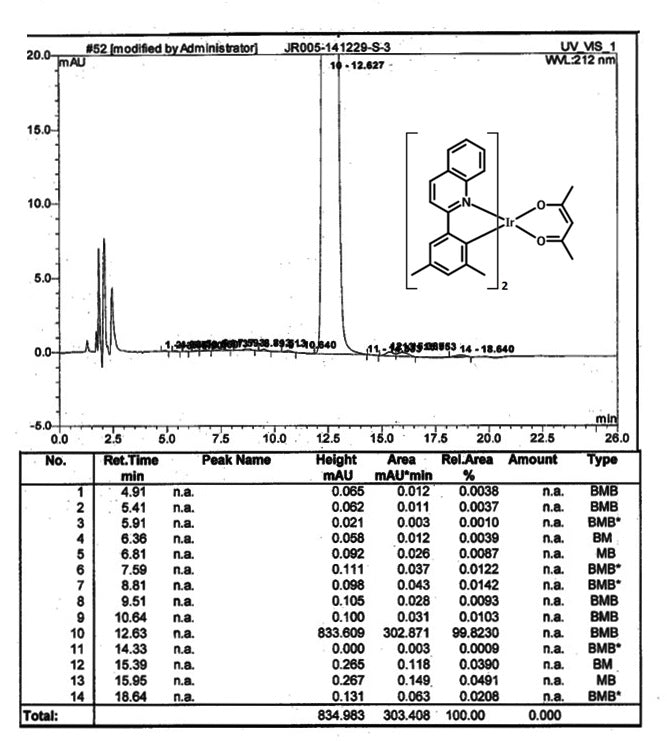
Bis(2-(3,5-
Compared with Ir(phq)2acac, Ir(dmpq)2(acac) has a higher quantum efficiency. The dmpq ligand is methylated version of the phq (2-phenylquinoline) ligand, with methyl substitutions on the phenyl group. It is believed that the higher efficiency is a result of this methylation of the phq ligand.
General Information
| CAS number | 1056874-46-4 |
| Chemical formula | C39H35IrN2O2 |
| Molecular weight | 755.94 g/mol |
| Absorption | λmax 434 nm (in CH2Cl2) [1] |
| Fluorescence | λem 594 nm (in CH2Cl2) |
| HOMO/LUMO | HOMO = 5.31 eV, LUMO = 3.26 eV [2] |
| Synonyms |
|
| Classification / Family | Red dopant material, Organic Light-Emitting Diodes (OLEDs), Organic electronics |
Product Details
| Purity | >99.5% (sublimed*) |
| Melting point | n/a |
| Appearance | Dark-red powder/crystals |
*Sublimation is a technique used to obtain ultra pure-grade chemicals. For more details about sublimation, please refer to the Sublimed Materials for OLED devices page.
Chemical Structure

Device Structure(s)
| Device structure | ITO/DNTPD (40 nm)/Bebq2:Ir(dmpq)2(acac) (3%, 30 nm)/Bebq2 (20 nm)/LiF (0.5 nm)/Al (100 nm) [1] |
| Colour | Red  |
| Max. Current Efficiency | 20.3 cd/A |
| Max. Power Efficiency | 23.9 lm W−1 |
| Device structure | ITO (150 nm)/TAPC(20 nm)/ TCTA (10 nm)/ TCTA:B3PYMPM* :Ir(ppy)2(acac):Ir(mphq)2(acac) (30 nm, 8 wt%, 0.5 wt%)/ B3PYMPM (45 nm)/ LiF (0.7 nm)/Al (100 nm) [2] |
| Colour | Orange  |
| Max. EQE | 25.4% |
| Max. Power Efficiency | 49.5 lm W−1 |
| Device structure | ITO (150 nm)/TAPC (20 nm)/TCTA (10 nm)/TCTA:B3PYMPM* :Ir(dmpq)2(acac) (5 nm, 3 wt%)/TCTA:B3PYMPM:Ir(ppy)2(acac) (25 nm, 8 wt%)/B3PYMPM (45 nm)/LiF (0.7 nm)/Al (100 nm) [3] |
| Colour | Orange  |
| Max. EQE | 22.8% |
| Max. Power Efficiency | 70.1 lm W−1 |
| Device structure | p-PI (2 mm)/ITO (120 nm)/MoO3 (5nm)/TAPC (50 nm)/TCTA:Ir(dmpq)2(acac) (10 wt%, 6 nm)/TCTA (2 nm)/TCTA:FIrpic (20 wt%, 4 nm)/TPBi (2 nm)/TPBi:Ir(ppy)3 (8 wt% 6 nm)/TPBi (75 nm)/LiF/Al [4] |
| Colour | White  |
| EQE@ 3 mA/cm2 | 19.0% |
| Power Efficiency@ 100 cd/m2 | 32.1 lm W−1 |
| Device structure | ITO (100 nm)/TAPC (75 nm)/NPB (10 nm)/NPB:B3PYMPM:Ir(mphq)2acac (30 nm, 3.5 mol%)/ B3PYMPM (10 nm)/B3PYMPM:Rb2CO3 (45 nm, 2 wt%)/Al (100 nm) |
| Colour | Red  |
| Max. EQE | 27.6% |
*For chemical structure information, please refer to the cited references.
Characterisation

Pricing
| Grade | Order Code | Quantity | Price |
| Sublimed (>99.5% purity) | M801 | 100 mg | £161.00 |
| Sublimed (>99.5% purity) | M801 | 250 mg | £322.00 |
MSDS Documentation
 Ir(dmpq)2(acac) MSDS sheet
Ir(dmpq)2(acac) MSDS sheet
Literature and Reviews
- Highly Efficient Red Phosphorescent Dopants in Organic Light-Emitting Devices, D. Kim et al., Adv. Mater., 23, 2721–2726 (2011); DOI: 10.1002/adma.201100405.
- Low Roll-Off and High Effi ciency Orange Organic Light Emitting Diodes with Controlled Co-Doping of Green and Red Phosphorescent Dopants in an Exciplex Forming Co-Host, S. Lee et al., Adv. Funct. Mater., 23, 4105–4110 (2013); DOI: 10.1002/adfm.201300187.
- High efficiency and non-color-changing orange organic light emitting diodes with red and green emitting layers, S. Lee et al., Org. electronics, Organic 14, 1856–1860 (2013); http://dx.doi.org/10.1016/j.orgel.2013.04.020.
- Enhanced Outcoupling in Organic Light-Emitting Diodes via a High-Index Contrast Scattering Layer, T-W. Koh et al., ACS Photonics, 2, 1366−1372 (2015); DOI: 10.1021/acsphotonics.5b00346.
- Phosphorescent dye-based supramolecules for high-efficiency organic light-emitting diodes, K-H. Kim et al., Nat. commun., 5, 4769; DOI: 10.1038/ncomms5769.
To the best of our knowledge the technical information provided here is accurate. However, Ossila assume no liability for the accuracy of this information. The values provided here are typical at the time of manufacture and may vary over time and from batch to batch.



